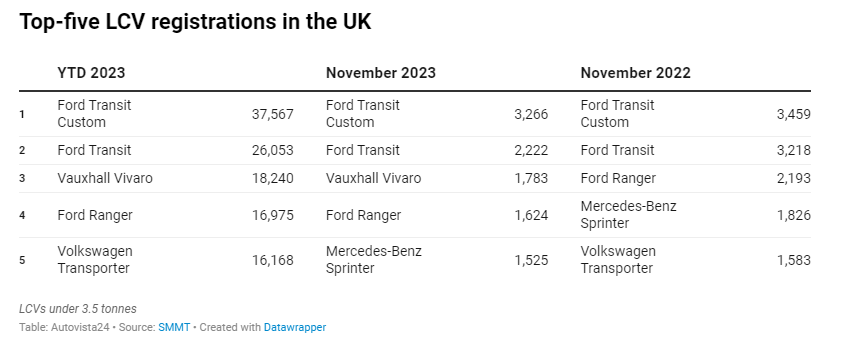The UK’s new light-commercial vehicle (LCV) market grew in November while the used market saw a large number of Euro 6 models change hands. Andy Picton, chief commercial vehicle editor at Glass’s (part of Autovista Group) unpacks the trends.
Data from the Society of Motor Manufacturers and Traders (SMMT) reveals that LCV registrations in the UK grew for the eleventh consecutive month in November. A total of 27,433 new units took to the roads, up 12.7% compared to 12 months ago. Registrations in the year-to-date reached 311,754 units, an increase of 19.8% on 2022.
Vans weighing between 2.5 and 3.5 tonnes gross-vehicle weight (GVW) saw deliveries decline by 1.6% year on year to 18,367 units. This category represented 66% of all new deliveries in the month. All other segments recorded year-on-year growth. Pickups recorded a 14.9% increase in registrations. Vans below 2 tonnes GVW rose by 10.4% while those between 2 and 2.5 tonnes GVW rose by 161.1%.
Ford Transit on top
Ford posted another strong month in November. The Transit Custom (3,266 units) and Transit (2,222 units) came in first and second respectively, while the Ranger pickup (1,624 units) finished fourth.
Stellantis also performed well, with the Vauxhall Vivaro (1,783 units) and Citroen Berlingo (1,311 units) finishing in third and seventh respectively. Meanwhile, the Mercedes-Benz Sprinter finished in fifth (1,525 units).
Elsewhere in the top 10, the Volkswagen (VW) Transporter claimed sixth (1,416 units) and the Toyota Hilux eighth (934 units). In ninth place was the Maxus Deliver 9 (819 units), while close behind was the Renault Trafic in 10th (816 units).

ZEV mandate impact
Electric LCV sales have dipped in the run up to the introduction of the zero-emissions vehicle (ZEV) mandate on 3 January 2024. Manufacturers will need 10% of their annual fleet to come from new electric van sales, with units sold from the implementation of the mandate counting towards this goal, while those beforehand will not.
This provides an incentive for manufacturers to pause deliveries, delaying them until the new year. A total of 1,631 all-electric vans were registered in November, down 17.4% on 12 months ago. These units made up 5.9% of the overall market in the month, down from 8.1% in November 2022. The latest figures mean that the year-to-date BEV registrations of 17,289 units account for only 5.5% of the overall market, down 0.3% on the same point in 2022.
With diesel-powered vehicles still making up 91.9% of all LCVs registered this year – down only 0.1% on the same period in 2022 – a lot of effort is needed to drive electric van adoption. This is unlikely to be helped by the introduction of tough Rules of Origin requirements, currently scheduled to come into force at the start of 2024.
The Rules of Origin will see tariffs placed on any all-electric van originating from the EU – currently 83.6% of the year-to-date total – potentially resulting in a reduction in choice and affordability. Unless delayed or cancelled, these new rules will see the new ZEV mandate come under pressure before it even begins.
Cleaner options in used-van market
In an improving marketplace which demands newer and cleaner stock, over 70% of all LCV sales at auction were Euro 6 models, with an average age of 53.5 months. Average mileage was just over 71,300 miles, while the average selling price was £10,825 (€12,633).
Over a quarter of all stock sold was Euro 5 or older, with an average age of 146 months, mileage of nearly 108,500 miles and sale price of just over £3,000. Used electric vans made up less than 2% of all sales at auction with an average price of nearly £5,400.
The volume of sales decreased by 9.5% over the month, but average prices increased by over 6.5%. This reflected a steady market with younger stock, but a lack of variety. Although average sales prices increased quite considerably over the month, figures remain 11% behind the same point last year.
The average age of all vehicles sold sat at 77.9 months, up 5.1 months on October and 0.8 months on November 2022. The average monthly mileage fell by 2.83% to 80,248 miles, 1.35% lower than in November 2022.
More medium vans were sold at auction than any other vehicle type, accounting for nearly 34% of all sales through this channel. Large vans accounted for 26.6% and small vans 26.3%. Volumes of 4×4 stock accounted for only 13.4% of all sales, but attracted the strongest average sales prices of £13,389, up £240 on October. Large vans covered more distance than any other type at an average of 85,339 miles. This was over 6,200 miles less than in October and reflects the younger model mix on offer.
First-time conversion rates for November declined by 0.8% to 75.8% overall, a figure that is 3.2% lower than at the same point 12 months ago. Broken down, the best conversion rates were seen in the medium panel van sector at 80.1% (up 2.9% on October). Meanwhile, a conversion rate of 65.2% (down 10.2%) in the 4×4 pickup sector returned the lowest result.
Used vehicles observed for sale in the wholesale market last month remained relatively static at 42,500 units. A total of 45.7% of all vehicles on sale were valued at £20,000 or more, while 36% were on sale for between £20,000 and £10,000. At the lower end of the market, those vehicles on sale in the £10,000 to £5,000 price bracket made up 14% of the market, while 4.3% were on sale for less than £5,000.
Read about used-car markets developments in other European markets.
This content is brought to you by Autovista24.


 Close
Close